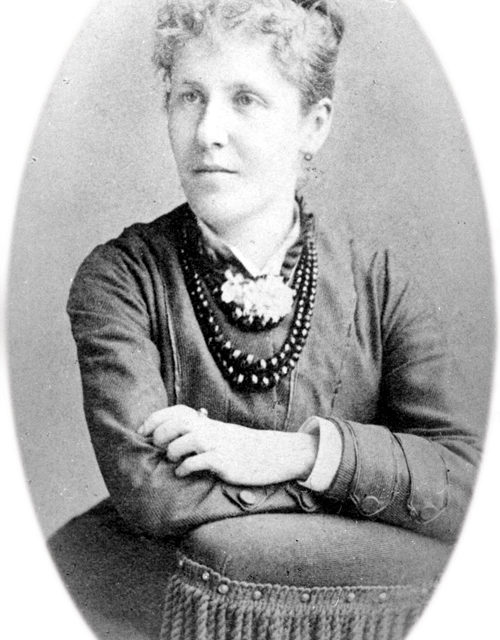
Mary Shellman in 1877.
Written By Scott Braden
On May 30, when the nation celebrates Memorial Day, many Carroll Countians will honor the nation’s fallen warriors by participating in the 144th annual Westminster Memorial Day parade.
Sponsored by the American Legion, the Westminster Memorial Day parade is considered by many to be one of the oldest, continuously held Memorial Day parades in the country.
Among those marching in the parade – which kicks off at 10 a.m. and includes many local organizations – will be students from St. John’s Catholic School, as well as various Cub Scout packs and Boy Scout troops in and around the area. The parade is followed by a memorial service at the Westminster Cemetery.
The inclusion of the young in the remembrance brings the parade back to its origins, when Mary Bostwick Shellman – heeding Gen. John A. Logan’s 1868, General Order No. 11, which directed communities to adorn each grave of a Union soldier with a flower – gathered school children to march through Westminster on May 30 to the town cemetery to honor the North’s deceased soldiers.
Born in 1849, Mary Shellman would go on to lead the area’s Memorial Day observances for 60 years. But her role as founder and leader of the Westminster Memorial Day parade was only one of Shellman’s many accomplishments.
“Shellman was the third child of Colonel James M. Shellman and Catherine Jones Shellman,” explained Catherine Baty, the curator of collections for the Historical Society of Carroll County. “Col. Shellman (1801 – 1851) served as an officer in the Maryland Militia, worked as an attorney, served as the first burgess of Westminster and as a member of the Maryland Legislature. He is credited with designing Carroll County’s courthouse shortly after the county’s founding in 1837.
“Catherine Shellman’s father, Phillip Jones, was an early Westminster merchant. After her husband’s death in 1851, Catherine Shellman (1815 – 1898) opened a small private school in her home. There were four Shellman children: Fanny Cheston Schley Shellman (1842-1909), Harry Jones Shellman (1843-1894), Mary Bostwick Shellman, and James Meriwether Shellman, Jr. (1851-1922).”
At the age of 12, Mary Shellman – who never married – persuaded the mayor of Westminster to name a lane Sycamore Street when her beloved sycamore tree was cut down to widen the road. It was a clear indication of Shellman’s dynamic personality.
Later, she undertook the care, feeding and entertainment of the residents of the Carroll County Almshouse (where the Carroll County Farm Museum is located today). She buried Confederate soldiers in her family plot, which was considered controversial at the time. In fact, her work on behalf of Civil War veterans led to honorary membership in the Grand Army of the Republic, as well as other veterans’ associations.
As the first manager of the Westminster Division of the Chesapeake and Potomac Telephone Company, Shellman’s responsibilities included working as an operator and overseeing the finances of the branch.
In 1889, she joined the American Red Cross at the time of the Johnstown, Pa. flood, and met Clara Barton. Baty said Shellman also “established Westminster’s first Boy Scout troop and served as scoutmaster under the name ÔM.B. Shellman’ for several years before the national organization realized she was a woman and relieved her of responsibilities.”
Shellman was also a writer. She was most noted for composing the words of the Memorial Hymn for Arlington National Cemetery, the Memorial Day poem for Antietam Battlefield, and the rally song for William McKinley’s 1900 presidential campaign. In 1875, she edited Westminster’s literary newspaper, Amphions Journal. In addition to writing, she was involved with various theatrical productions in town.
Shellman was also a suffragette firmly behind political reform and a member of the Women’s Christian Temperance Union.
“Those two always seem to go hand in hand in affiliation,” said Timmi Pierce, executive director of the Historical Society of Carroll County.
“If women belonged in one, they seemed to belong to the other. It kept the men in line.”
But the bottom line for Shellman, who died in 1938 at the age of 89, was that she was a renaissance woman.
“She was quite outstanding for that time period, being a woman who did all these things,” said Baty. “She was definitely pushing the envelope. She was born 100 years too soon, because I think she’d fit in today.”
“She’d be Gloria Steinem plus,” said Pierce. “Mary Shellman was an icon of voluntarism and involvement in the county.”

